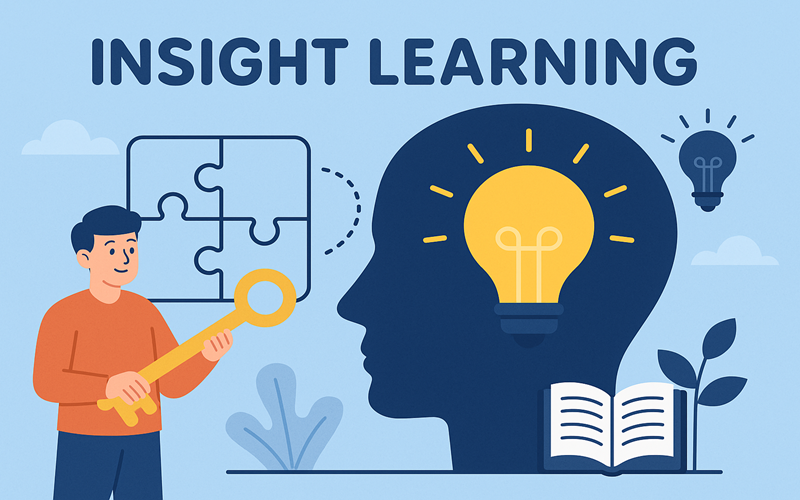Have you ever struggled with a tricky puzzle, only to suddenly shout, “I’ve got it!”? That magical moment when the solution clicks in your brain is called insight learning. It’s like a light bulb turning on in your mind, helping you understand something new without needing step-by-step instructions. In this article, we’ll explore how insight learning works, why it’s important, and how you can use it to solve problems in school, games, and everyday life!
What Is Insight Learning?
Insight learning is a way of solving problems through sudden understanding rather than trial and error. Imagine trying to solve a jigsaw puzzle. Instead of randomly testing pieces, you might stare at the shapes and colors until—snap!—you see how they fit together. That “aha!” moment in action.
This type of learning was first studied by psychologist Wolfgang Köhler in the 1920s. He observed chimpanzees using sticks to reach bananas placed outside their cages. The chimps didn’t learn through repeated mistakes; instead, they suddenly figured out how to use the tools. Köhler called this “aha” moment insight learning.
Read More: how to make tool in little alchemy 1
How Does Insight Learning Work?
Our brains are like detectives, always searching for patterns and connections. Here’s a simple breakdown of how happens:
-
The Problem: You face a challenge, like a math problem or a broken toy.
-
The Struggle: You try different ideas, but nothing works.
-
The Incubation: Your brain quietly pieces together clues in the background.
-
The “Aha!” Moment: Suddenly, the solution becomes clear!
-
Verification: You test your idea to make sure it works.
For example, think of Archimedes, the ancient scientist who shouted “Eureka!” when he realized how to measure the volume of irregular objects while taking a bath. His brain connected water displacement to solving the problem—a classic.
Insight Learning vs. Other Types of Learning
Not all learning is the same. Let’s compare:
-
Trial and Error: Trying repeatedly until something works (like guessing passwords).
-
Rote Learning: Memorizing facts through repetition (like multiplication tables).
-
Insight Learning: Solving problems through sudden understanding (like cracking a riddle).
While trial and error can be slow, is faster and more creative. It’s like your brain skipping steps to jump straight to the answer!
Examples of Insight Learning in Everyday Life
-
School Projects: Figuring out how to build a volcano model after days of confusion.
-
Video Games: Discovering a hidden shortcut to beat a tough level.
-
Sports: Realizing a new strategy to score a goal during a game.
-
Cooking: Combining unexpected ingredients to fix a recipe.
Even animals use insight learning! Crows, for instance, bend wires to hook food from narrow tubes. They don’t practice—they just “get it.”
Why Is Insight Learning Important?
-
Boosts Creativity: It encourages thinking outside the box.
-
Saves Time: Solutions come faster than trial and error.
-
Builds Confidence: Solving tough problems feels rewarding!
-
Prepares for Real Life: Many real-world challenges require quick, clever thinking.
Teachers and parents love because it helps kids become independent problem-solvers.
How to Encourage Insight Learning
Want more “aha!” moments? Try these tips:
-
Stay Curious: Ask questions and explore new ideas.
-
Take Breaks: Stepping away from a problem lets your brain process info.
-
Play Brain Games: Puzzles, riddles, and strategy games spark creative thinking.
-
Stay Positive: Stress blocks creativity—keep calm and keep trying!
FAQs About Insight Learning
1. Can insight learning be taught?
Yes! By practicing problem-solving and staying open-minded, anyone can improve their ability to have “aha!” moments.
2. Is insight learning the same as “gut feeling”?
Not quite. A gut feeling is instinctive, while involves connecting ideas logically—even if it feels sudden.
3. Do animals really use insight learning?
Absolutely! From chimps using tools to octopuses escaping jars, many animals show clever problem-solving skills.
Final Thoughts
Insight learning is like a superpower hidden in your brain. It helps you tackle challenges with creativity and confidence. Whether you’re solving homework, fixing a bike, or inventing a new game, those “aha!” moments make learning fun and exciting. So next time you’re stuck, take a deep breath—your brilliant idea might be just around the corner!
Read More: investing with little money
